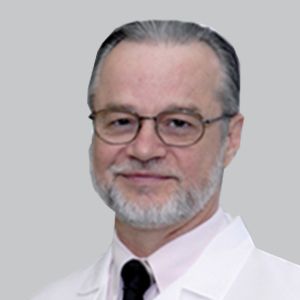Article
New Brain Stimulation Technology Effective for Parkinson in First Double-blind, Sham-controlled Trial
Author(s):
New brain stimulation technology is proven effective for Parkinson in the first double-blind, sham-controlled trial of this type of intervention.
Jerrold Vitek, MD, PhD, McKnight Professor and Chair, Department of Neurology, University of Minnesota Medical School

Jerrold Vitek, PhD, MD
A new deep brain stimulation (DBS) system was found to improve symptoms of Parkinson disease in the first double-blind, sham-controlled trial to be conducted with this type of intervention.
Jerrold Vitek, MD, PhD, McKnight Professor and Chair, Department of Neurology, University of Minnesota Medical School, Minneapolis, MN, and coordinating principle investigator of the INTREPID study described at the International Congress of Parkinson’s Disease and Movement Disorders, in Hong Kong, told NeurologyLive that both the technology of the new Vercise system (Boston Scientific) and the methodology of the clinical trial for the system are novel.
"To date, there has never been a double-blind, randomized, sham-controlled trial of DBS. There has been a single-blind study done years ago by the VA (US Department of Veterans Affairs)," Vitek said. "But this (double-blind, sham-controlled) is the best way to assess whether something is working."
The new DBS system is unique for enabling individual control of the current to each electrode of multiple implants. The manufacturer describes it as multiple independent current control, developed from their cochlear implant technology. Vitek characterizes it as technology that he and others working in movement disorders have been waiting for.
"You can have more precise control over the amount of current being delivered at each site, and can really fine-tune the current delivery spatially," he explained. "That's important and that hasn't been available before."
Vitek and colleagues identified 292 subjects from 23 U.S. medical centers with advanced Parkinson disease that was responsive to but not well controlled with levodopa. All subjects had at least a 2-year history of resting tremor, rigidity or bradykinesia, with at least 6 hours daily of disturbed motor functioning, and were on stable regimens of antiparkinsonian medications at baseline. Motor symptoms at pre-surgery baseline were measured by clinicians on the Unified Parkinson's Disease Rating Scale (UPDRS) III.
Each subject received the 8-electrode DBS system implanted bilaterally in the subthalamic nucleus (STN) for 12 weeks, with those randomized to the sham-control receiving a sub-therapeutic, low intermittent current. Evaluations conducted at 3, 6 and 12 months included the clinician-rated UPDRS III scores of motor symptoms and a battery of neuropsychological assessments, as well as patient-reported Parkinson disease diary of time spent "ON" (without dyskinesias) and their assessment of quality of life on the Parkinson's Disease Questionnaire (PDQ)-39 score.
The investigators reported that the study successfully met the primary endpoint, with a mean difference of 3.03 ± 4.2 hours from baseline to 12 weeks between the active and control groups in "ON" time, per diary. At 1 year, the improvement in "ON" time had increased in the active treatment group to 6-hours compared to baseline.
"If you look at your day and if you can get 6 more hours of improved "ON" time without troublesome dyskinesia, that's a good part of your day and that's pretty significant," Vitek emphasized.
He also noted that this was achieved in patients with no increase in their antiparkinsonian medications. "Patients who were getting active stimulation were actually able to reduce their medicine by a little over 30%," Vitek said. "That varies a great deal from patient to patient. With this kind of site in the brain (the STN), we almost have to reduce the medication because, if we don't, the stimulation has a compounding effect with the medicine and patients can get dyskinetic."
At the 1 year evaluation, the active treatment group demonstrated a 49.2% improvement in motor symptoms from baseline on the UPDRS III, as well as a significant improvement in quality of life, assessed with the PDQ-39. Other secondary endpoints that were met included safety measures of the procedure, with 2.7% incidence of infection and 1% incidence of peri-operative intracranial hemorrhage.
"The results of the INTREPID trial demonstrate that the use of a multiple source, constant-current DBS system is safe and effective in the treatment of Parkinson disease symptoms," the investigators concluded.
REFERENCE
Vitek J, Jain R, Starr P. INTREPID Trial: A Prospective,
Double blinded
, Multi-center Randomized Controlled Trial Evaluating Deep Brain Stimulation with a New Multiple-Source, Constant-Current Rechargeable System in Parkinson’s Disease [abstract]. Mov Disord. 2017; 32 (suppl 2). http://www.mdsabstracts.org/abstract/intrepid-trial-a-prospective-double-blinded-multi-center-randomized-controlled-trial-evaluating-deep-brain-stimulation-with-a-new-multiple-source-constant-current-rechargeable-system-in-parkinson/. Accessed October 23, 2018.




